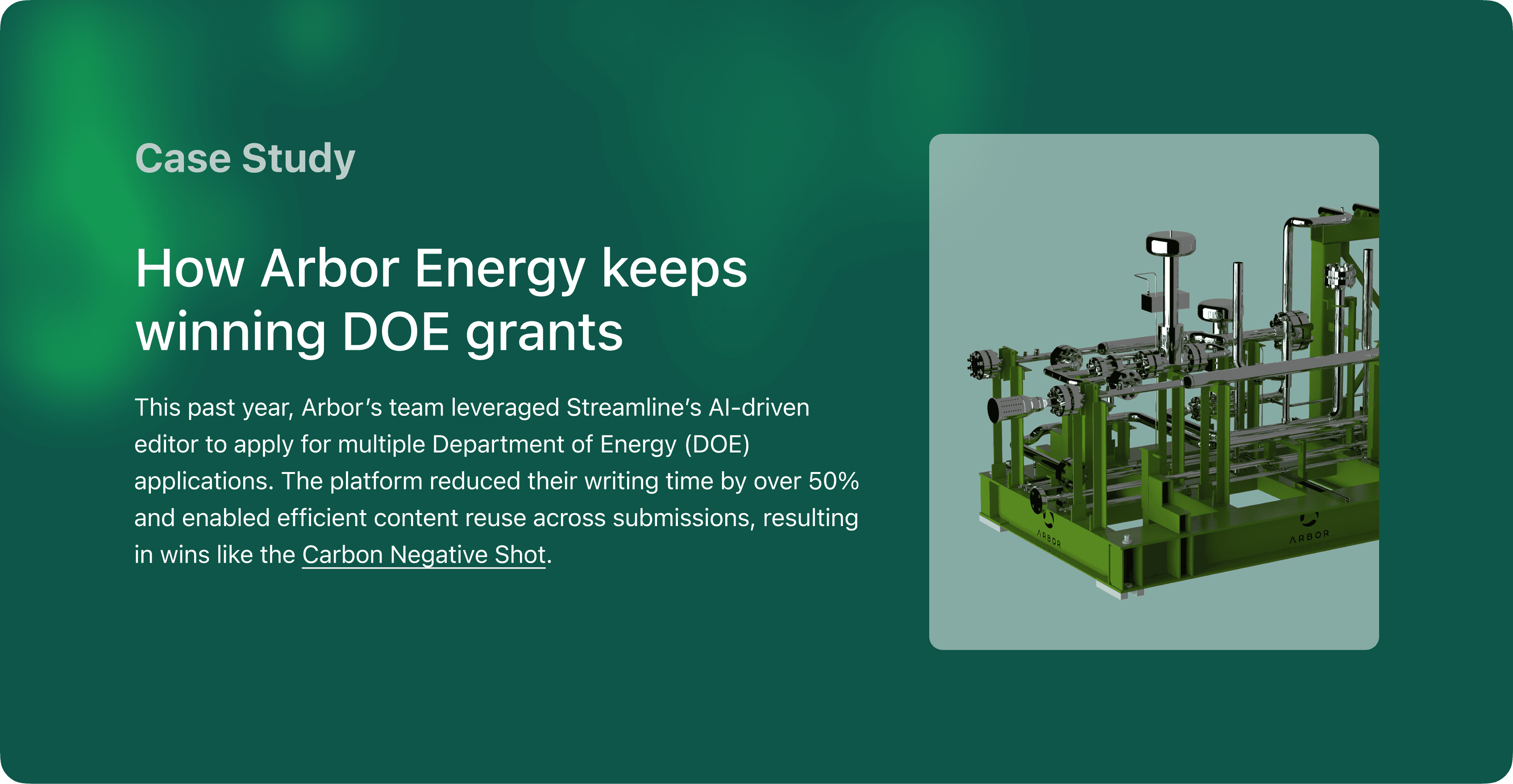



How Arbor Energy Keeps Winning DOE Grants
Friday, February 7, 2025
Rocket Science Meets Climate Action
Arbor Energy is turning rocket science into carbon-negative power. Instead of building technology to leave our planet, their team is using their expertise to save it.
Arbor’s story begins with a familiar scene: California skies glowing apocalyptic orange, smoke thick enough to blot out the sun. It was amid this devastating display that Brad Hartwig, then an engineer perfecting rocket engines at SpaceX, realized his unique position to help. Today, Arbor’s growing team of aerospace veterans and climate experts are commercializing technology straight out of science fiction: revolutionary power plants that combine clean energy generation with industrial-scale carbon capture to heal our atmosphere.
Nature’s Solution, Supercharged
Let’s revisit nature’s oldest and most efficient carbon capture system: plants. For millennia, plants have captured and stored atmospheric CO2 through photosynthesis. However, nature’s solution has a time limit. When plants die or shed biomass, decomposition releases their stored carbon back into the atmosphere. In our modern world, the sheer scale of organic waste we produce —such as agricultural residues, food waste, and forest undergrowth — have turned this natural cycle into a significant climate challenge.
The brilliance of Arbor's approach lies in its fusion of space technology with nature's carbon-capturing prowess. Rockets typically carry pure oxygen to burn fuel in the vacuum of space in a process known as oxycombustion. This produces a remarkably clean reaction: when organic matter burns in pure oxygen, it produces CO2 and water vapor, which condenses out as the exhaust cools. Arbor Energy simply replaces rocket fuel with biomass. Their system lets photosynthesis do the heavy lifting of scrubbing CO2 from the air, then utilizes oxycombustion and carbon sequestration to ensure that carbon stays permanently removed.
Here’s where aerospace engineering takes this process to another level. Arbor’s turbomachinery, born from rocket propulsion systems that the team helped pioneer, uses the CO2 stream generated from oxycombustion as a working fluid. This highly-pressurized CO2 stream expands through an ultra-efficient turbine to generate power, then cycles back through the system in a closed loop before being split off for permanent storage underground. All the energy needed to run the entire process is produced by the biomass combustion itself. It’s a perfect example of space-age efficiency: nothing is wasted, and every component serves multiple purposes.
From Blueprint to Reality
Arbor Energy’s team has already proven their technology works at scale. They are building their first commercial pilot in Southwest Louisiana, a project accelerated by multiple Department of Energy awards, and recently announced a multi-year agreement with Microsoft. Throughout this process, Arbor's team leveraged Streamline's AI-driven editor to apply for multiple DOE applications. The platform reduced their writing time by over 50% and enabled efficient content reuse across submissions, resulting in major award wins – including the prestigious Carbon Negative Shot.
Fully operational, Arbor will deliver carbon removal at a price well below $100 per ton, decimating current benchmarks. But the impact extends far beyond efficient carbon capture. Every Arbor facility creates a cascade of benefits: preventing wildfires by processing excess forest biomass, generating revenue for rural communities through clean power and carbon credits, strengthening grid resilience, improving forest health, protecting watersheds, and supporting biodiversity. It's comprehensive climate action that transforms restoration into renaissance.
The Next Big Leap
With plans to remove 10 gigatonnes of CO2 annually by 2050, Arbor's ambitions match the magnitude of our climate crisis. Their compact, modular design means new facilities can be deployed in months instead of years. And with abundant sustainable biomass available globally, these aren't just dreams – they're engineering objectives backed by hard science and harder determination.
The team that once pushed the boundaries of space exploration is now pioneering the frontiers of climate restoration. It's a delicious irony: the same rocket science developed to leave Earth might be exactly what we need to save it. And while the Arbor team could probably design a way off this planet if they wanted to, they're too busy making sure we won't need one.



